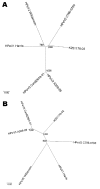Fourth human parechovirus serotype
- PMID: 17176575
- PMCID: PMC3290933
- DOI: 10.3201/eid1210.051647
Fourth human parechovirus serotype
Abstract
We identified a novel human parechovirus (HPeV) type (K251176-02) from a neonate with fever. Analysis of the complete genome showed K251176-02 to be a new HPeV genotype. Since K251176-02 could not be neutralized with antibodies against known HPeV serotypes 1-3, it should be classified as a fourth HPeV serotype.
Figures


References
Publication types
MeSH terms
LinkOut - more resources
Full Text Sources
